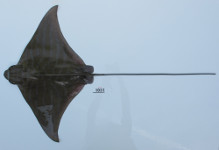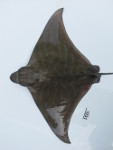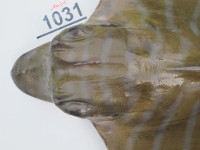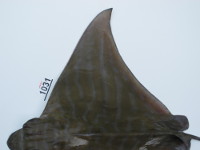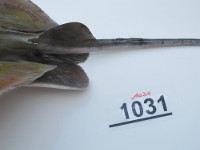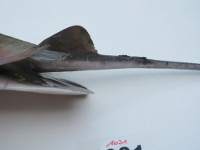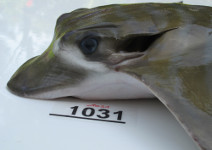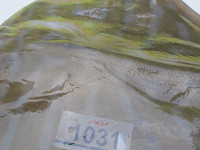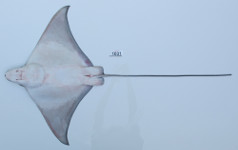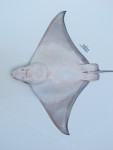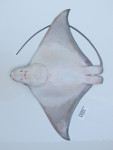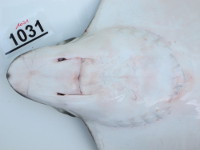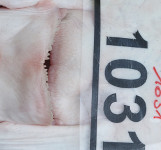Pteromylaeus bovinus
(Geoffroy Saint-Hilaire, 1817)
Bull ray
Classification: Elasmobranchii Myliobatiformes Myliobatidae
Reference of the original description
Poissons du Nil, de la Mer Rouge et de la Méditerranée, In Description de l'Egypte ou recueil des observations et des recherches qui ont été faites en Égypte pendant l'expedition de l'Armée français, publié par les ordres de sa Majesté–L'Empereur Napoléon le Grand., pl. 18–27.
Poissons du Nil, de la Mer Rouge et de la Méditerranée, In Description de l'Egypte ou recueil des observations et des recherches qui ont été faites en Égypte pendant l'expedition de l'Armée français, publié par les ordres de sa Majesté–L'Empereur Napoléon le Grand., pl. 18–27.
Image of the original description
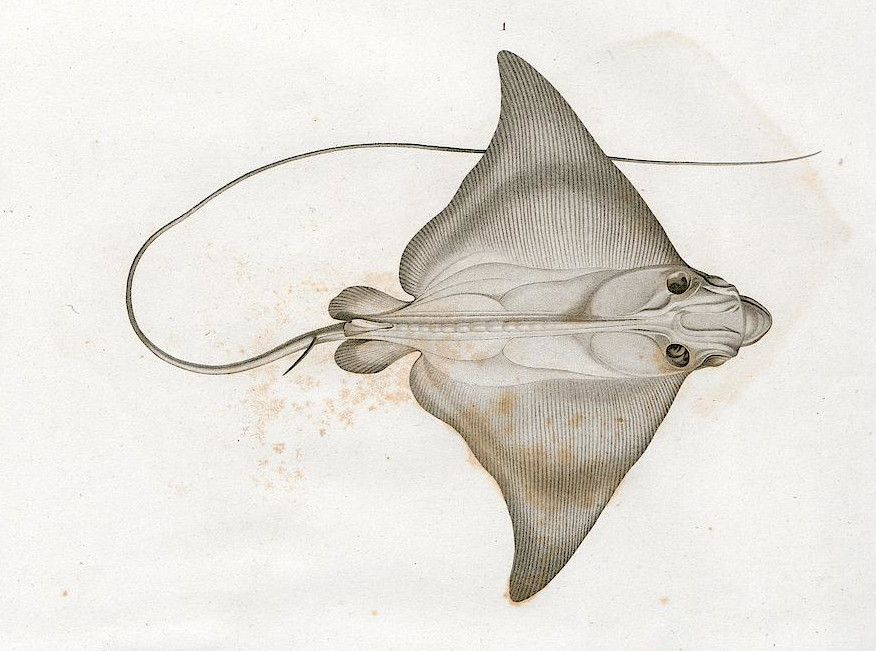
Pteromylaeus bovinus (Geoffroy Saint-Hilaire, 1817) Plate 26 Fig. 1

Pteromylaeus bovinus (Geoffroy Saint-Hilaire, 1817) Plate 26 Fig. 1
Synonyms / new combinations and misspellings
Aetobatis bovina, Aetomylaeus bovina, Aetomylaeus bovinus, Myliobates episcopus, Myliobatis bonaparti, Myliobatis bovina, Myliobatis episcopus, Pteromylaeus bovina, Pteromylaeus cf. bovina, Raja episcopus
Aetobatis bovina, Aetomylaeus bovina, Aetomylaeus bovinus, Myliobates episcopus, Myliobatis bonaparti, Myliobatis bovina, Myliobatis episcopus, Pteromylaeus bovina, Pteromylaeus cf. bovina, Raja episcopus
Types
Pteromylaeus bovinus
Aetomylaeus bovinus
XXXX: No types known;
Myliobatis bonaparti
Syntype: MNHN: 2356; MNHN: A-8715;
Pteromylaeus bovinus
Aetomylaeus bovinus
XXXX: No types known;
Myliobatis bonaparti
Syntype: MNHN: 2356; MNHN: A-8715;
Description :
Citation: Pteromylaeus bovinus (Geoffroy Saint-Hilaire, 1817): In: Database of modern sharks, rays and chimaeras, www.shark-references.com, World Wide Web electronic publication, Version 05/2025
Please send your images of "Pteromylaeus bovinus" to info@shark-references.com
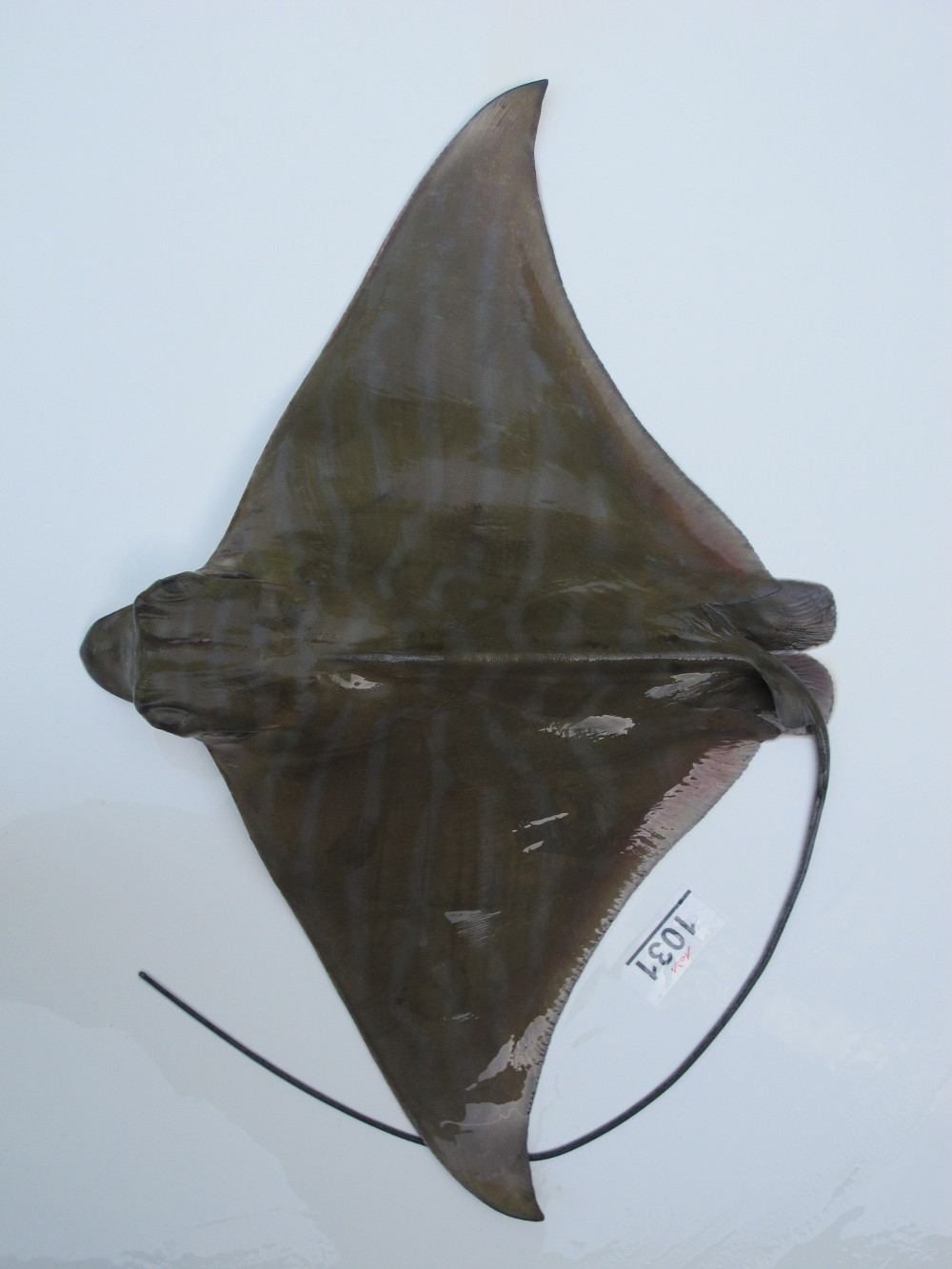
Pteromylaeus bovinus (Geoffroy Saint-Hilaire, 1817) (ERB 1031), female, 73, 0 DW, 111, 2 TL, Eastern Mediterranean, Turkey © Frederik H. Mollen (Elasmobranch Research Belgium)

Pteromylaeus bovinus (Geoffroy Saint-Hilaire, 1817) (ERB 1031), female, 73, 0 DW, 111, 2 TL, Eastern Mediterranean, Turkey © Frederik H. Mollen (Elasmobranch Research Belgium)
Common names
 Afrikanischer adlerrochen,
Afrikanischer adlerrochen,  Afrikanischer gefleckter adlerrochen,
Afrikanischer gefleckter adlerrochen,  Gestreifter Adlerrochen,
Gestreifter Adlerrochen,  Arzobispo,
Arzobispo,  Bon Jesús,
Bon Jesús,  Chucho,
Chucho,  Chucho vaca,
Chucho vaca,  Milá,
Milá,  Obispo,
Obispo,  Peje obispo,
Peje obispo,  Pez obispo,
Pez obispo,  Ratón,
Ratón,  Aigle-vachette,
Aigle-vachette,  Mourine,
Mourine,  Mourine vachette,
Mourine vachette,  Mourine évêque,
Mourine évêque,  Mourine évêque bovine,
Mourine évêque bovine,  Raie aigle,
Raie aigle,  Bull ray,
Bull ray,  Bullray,
Bullray,  Duckbill,
Duckbill,  Duckbill ray,
Duckbill ray,  Eagle ray,
Eagle ray,  Bugghiu,
Bugghiu,  Colombo,
Colombo,  Colombo di mare,
Colombo di mare,  Ferraccia,
Ferraccia,  Matan,
Matan,  Muggiu,
Muggiu,  Nottola,
Nottola,  Orineglia,
Orineglia,  Oxella,
Oxella,  Patesse,
Patesse,  Stramasso,
Stramasso,  Tattarita,
Tattarita,  Tistuni,
Tistuni,  Vaccarella,
Vaccarella,  Vaccariella,
Vaccariella,  Vacche,
Vacche,  Vascarella,
Vascarella,  Vescovo,
Vescovo,  Bispo,
Bispo,  Papa,
Papa,  Peixe-bispo,
Peixe-bispo,  Ratao bovino,
Ratao bovino,  Ratão-bispo
Ratão-bispo
 Afrikanischer adlerrochen,
Afrikanischer adlerrochen,  Afrikanischer gefleckter adlerrochen,
Afrikanischer gefleckter adlerrochen,  Gestreifter Adlerrochen,
Gestreifter Adlerrochen,  Arzobispo,
Arzobispo,  Bon Jesús,
Bon Jesús,  Chucho,
Chucho,  Chucho vaca,
Chucho vaca,  Milá,
Milá,  Obispo,
Obispo,  Peje obispo,
Peje obispo,  Pez obispo,
Pez obispo,  Ratón,
Ratón,  Aigle-vachette,
Aigle-vachette,  Mourine,
Mourine,  Mourine vachette,
Mourine vachette,  Mourine évêque,
Mourine évêque,  Mourine évêque bovine,
Mourine évêque bovine,  Raie aigle,
Raie aigle,  Bull ray,
Bull ray,  Bullray,
Bullray,  Duckbill,
Duckbill,  Duckbill ray,
Duckbill ray,  Eagle ray,
Eagle ray,  Bugghiu,
Bugghiu,  Colombo,
Colombo,  Colombo di mare,
Colombo di mare,  Ferraccia,
Ferraccia,  Matan,
Matan,  Muggiu,
Muggiu,  Nottola,
Nottola,  Orineglia,
Orineglia,  Oxella,
Oxella,  Patesse,
Patesse,  Stramasso,
Stramasso,  Tattarita,
Tattarita,  Tistuni,
Tistuni,  Vaccarella,
Vaccarella,  Vaccariella,
Vaccariella,  Vacche,
Vacche,  Vascarella,
Vascarella,  Vescovo,
Vescovo,  Bispo,
Bispo,  Papa,
Papa,  Peixe-bispo,
Peixe-bispo,  Ratao bovino,
Ratao bovino,  Ratão-bispo
Ratão-bispo
Short Description
Field marks and Diagnostic Features after EBERT & STEHMANN, 2013 [17836]: Field Marks: Disc transversally lozenge-shaped, about twice as wide as long. Undamaged tail about twice as long as disc, with a single, small dorsal fin on base originating far anterior to pelvic fins posterior margins, and with a long, serrated spine directly behind dorsal fin, after which the tail becomes rapidly thinner like a whip-lash. Snout short but pronounced as a subrostral lobe that is narrowly rounded to a pointed tip. Colour of disc above plain brown in adults, but with 7 to 8 pale transverse streaks in juveniles; underside whitish. Diagnostic Features: Disc transversally lozenge-shaped, about twice as wide as long, with long anterior margins strongly convex, falcate outer corners and strongly concave, somewhat undulated posterior margins; head elevated from disc, with eyes and spiracles on sides of head, forehead of which steeply sloping to subrostral lobe; snout short but pronounced as narrowly rounded to pointed tip formed by subrostral lobe of pectoral–fin radials being separated at sides of head from remainder of pectoral fins; pelvic fins subquadrate unilobed. Tail, if undamaged, about twice as long as disc, with a single, small dorsal fin on base originating far anterior to pelvic fins posterior margins, and a long, serrated spine originating directly behind dorsal fin; thereafter, the tail becoming rapidly thinner like a whip-lash. Skin smooth above and below. Usually seven rows of flat thick teeth in each jaw forming very massive grinding plates, teeth in middle row of upper jaw 6 to 8 times as broad as long. Colour: disc above plain brown in adults, but with 7 to 8 pale transverse streaks in juveniles; underside whitish, with wing tips more or less reddish-brown, the whip-lash tail dark
Field marks and Diagnostic Features after EBERT & STEHMANN, 2013 [17836]: Field Marks: Disc transversally lozenge-shaped, about twice as wide as long. Undamaged tail about twice as long as disc, with a single, small dorsal fin on base originating far anterior to pelvic fins posterior margins, and with a long, serrated spine directly behind dorsal fin, after which the tail becomes rapidly thinner like a whip-lash. Snout short but pronounced as a subrostral lobe that is narrowly rounded to a pointed tip. Colour of disc above plain brown in adults, but with 7 to 8 pale transverse streaks in juveniles; underside whitish. Diagnostic Features: Disc transversally lozenge-shaped, about twice as wide as long, with long anterior margins strongly convex, falcate outer corners and strongly concave, somewhat undulated posterior margins; head elevated from disc, with eyes and spiracles on sides of head, forehead of which steeply sloping to subrostral lobe; snout short but pronounced as narrowly rounded to pointed tip formed by subrostral lobe of pectoral–fin radials being separated at sides of head from remainder of pectoral fins; pelvic fins subquadrate unilobed. Tail, if undamaged, about twice as long as disc, with a single, small dorsal fin on base originating far anterior to pelvic fins posterior margins, and a long, serrated spine originating directly behind dorsal fin; thereafter, the tail becoming rapidly thinner like a whip-lash. Skin smooth above and below. Usually seven rows of flat thick teeth in each jaw forming very massive grinding plates, teeth in middle row of upper jaw 6 to 8 times as broad as long. Colour: disc above plain brown in adults, but with 7 to 8 pale transverse streaks in juveniles; underside whitish, with wing tips more or less reddish-brown, the whip-lash tail dark
Distribution
Eastern North Atlantic: from off Morocco and Madeira, but not at Azores, northward along the Iberian Peninsula to the southern Bay of Biscay. Also found throughout the Mediterranean Sea, but not in the Black Sea. Elsewhere, southward along the West African coast to off South Africa, where it is rare in the coldwater upwelling region off Namibia and the Western Cape region, but more common in the south-western Indian Ocean north to Zanzibar [17836].
Eastern North Atlantic: from off Morocco and Madeira, but not at Azores, northward along the Iberian Peninsula to the southern Bay of Biscay. Also found throughout the Mediterranean Sea, but not in the Black Sea. Elsewhere, southward along the West African coast to off South Africa, where it is rare in the coldwater upwelling region off Namibia and the Western Cape region, but more common in the south-western Indian Ocean north to Zanzibar [17836].
Human uses
fisheries: commercial; gamefish: yes
fisheries: commercial; gamefish: yes
Biology
Exhibit ovoviparity (aplacental viviparity), with embryos feeding initially on yolk, then receiving additional nourishment from the mother by indirect absorption of uterine fluid enriched with mucus, fat or protein through specialised structures [733]. Gestation about 6 months; 3-7 young produced [536]. Size at birth 45 cm WD (Ref. 6677). Feeds on fish and zoobenthos [536].
Exhibit ovoviparity (aplacental viviparity), with embryos feeding initially on yolk, then receiving additional nourishment from the mother by indirect absorption of uterine fluid enriched with mucus, fat or protein through specialised structures [733]. Gestation about 6 months; 3-7 young produced [536]. Size at birth 45 cm WD (Ref. 6677). Feeds on fish and zoobenthos [536].
Size / Weight / Age
250 cm TL (male/unsexed; (Ref. 40637)); max. published weight: 83.0 kg (Ref. 3965)
250 cm TL (male/unsexed; (Ref. 40637)); max. published weight: 83.0 kg (Ref. 3965)
Remarks
shark-references Species-ID=5289;
shark-references Species-ID=5289;
Parasites (arranged by Jürgen Pollerspöck)
Monogenea
Cestoda
Nematoda
Copepoda
Hirudinea
Monogenea
- Empruthotrema chisholmae Hernandez-Orts, Ahuir-Baraja, Raga & Montero, 2010 [21266] [34006]
- Heliocotyle kartasi Neifar & Euzet & Ben Hassine, 1999 [21211] [31118] [33260] [34006]
- Monocotyle myliobatis Taschenberg, 1878 [34006]
- Monocotyle sp. [31118]
- Myliocotyle pteromylaei Neifar, Euzet Ben Hassine 1999 [10846] [31118] [33260] [34006]
Cestoda
- Aberrapex sp. [23959]
- Caulobothrium katzi Caira & Jensen, 2021 [29436]
- Caulobothrium multispelaeum Caira & Jensen, 2021 [29436]
- Caulobothrium sp. [16908]
- Halysioncum sp. [19536]
Nematoda
Copepoda
- Lepeophtheirus acutus Heegaard, 1943 [26451]
- Pseudocharopinus pteromylaei Raibaut & Essafi, 1979 [17503] [27172] [32531]
Hirudinea
- Branchellion torpedinis Savigny, 1822 [24517]








